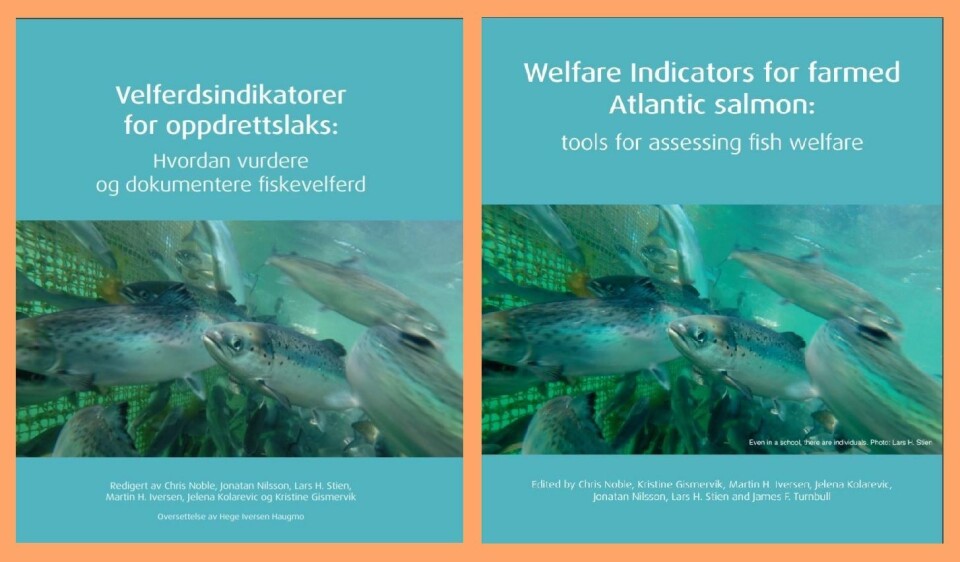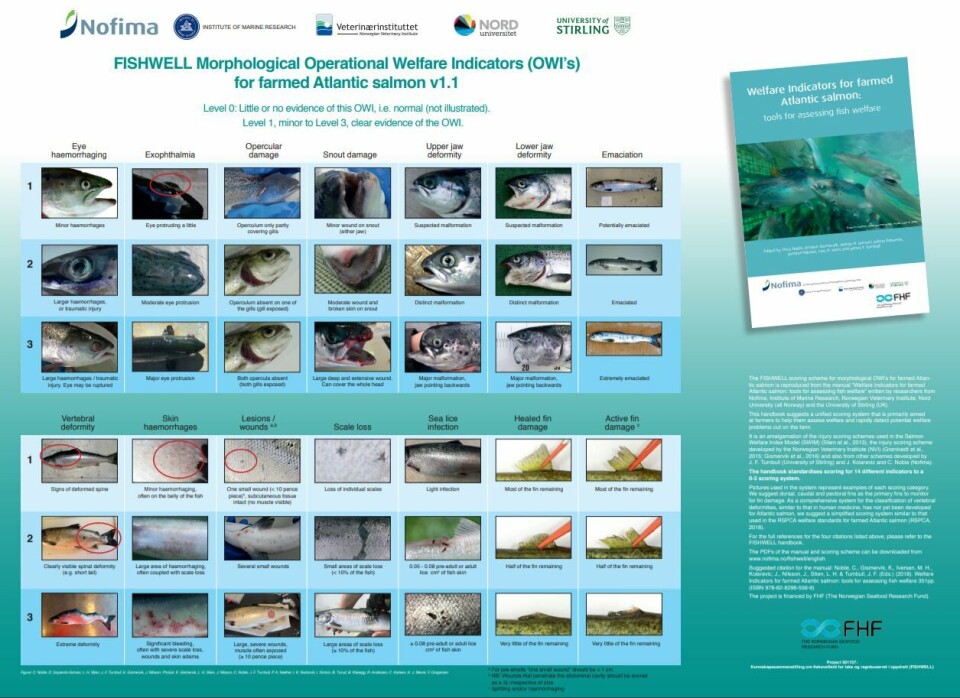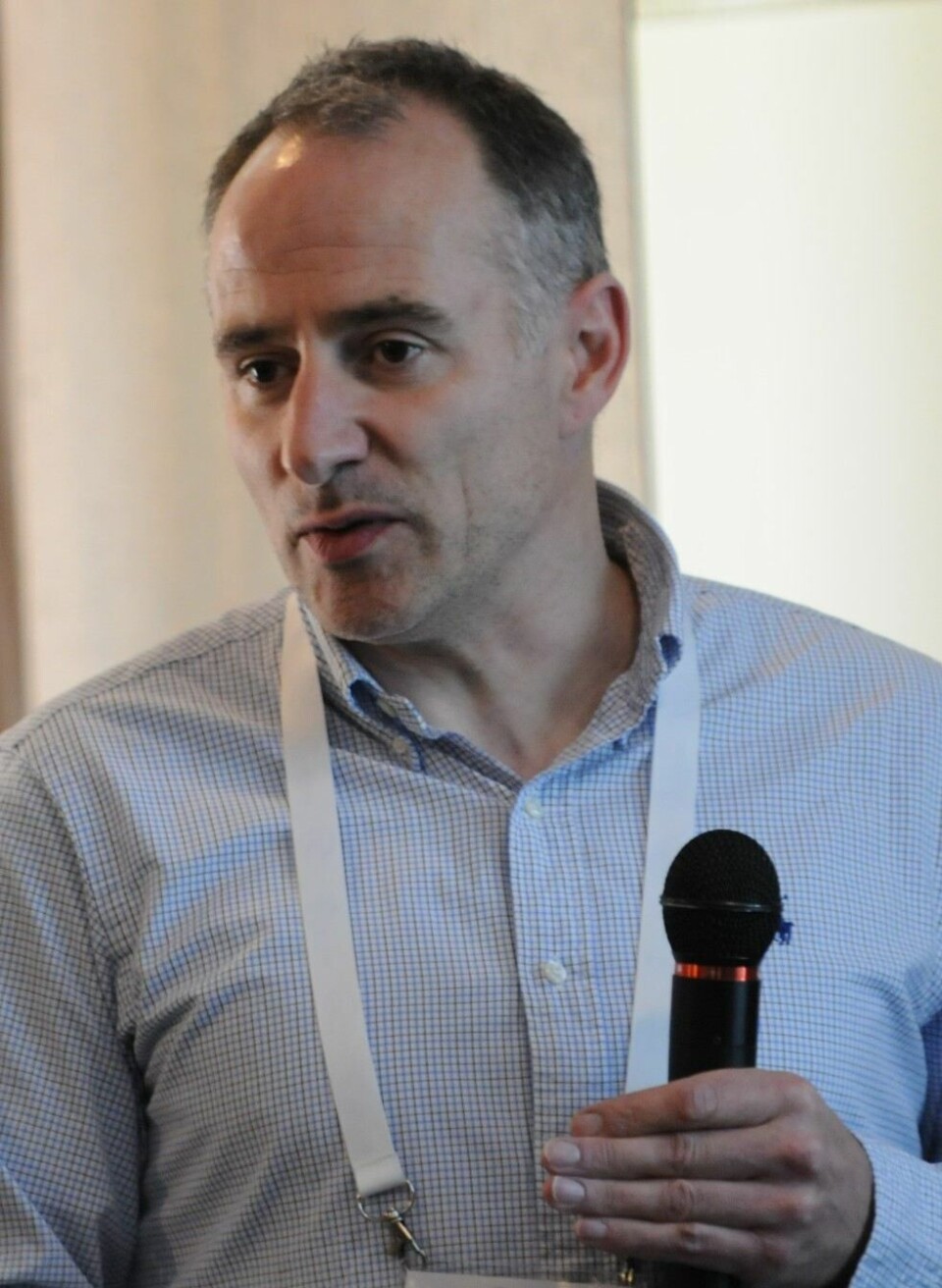
Talking our language: welfare indicators handbook now available in English
It’s been a long wait, but an English-language version of a successful Norwegian handbook on welfare indicators for farmed Atlantic salmon is now available online.
The Norwegian version of the FISHWELL handbook has been available for more than a year and proved so popular with the country’s salmon farmers that the writers had hard copies printed for use on farm sites.
The English version, called “Welfare Indicators for farmed Atlantic salmon – tools for assessing fish welfare”, won’t come in book form but can be downloaded for free as a 351-page PDF from the internet.

Illustrated poster
Fish farmers can also download an accompanying poster which uses photos to illustrate three stages of 14 operational welfare indicators (OWIs), graded from Level 1 (minor) to Level 3 (clear evidence of the OWI).
The OWIs illustrated are: eye haemorrhaging; exophthalmia; opercular damage; snout damage; upper jaw deformity; lower jaw deformity; emaciation; vertebral deformity; skin haemorrhaging; lesions / wounds; scale loss; sea lice infection; healed fin damage; active fin damage.
The handbook is a collaboration between fish welfare researchers and veterinarians at the food research institute Nofima, the Institute of Marine Research (IMR), the Norwegian Veterinary Institute (NVI), Nord University (all of whom are based in Norway) and the University of Stirling’s Institute of Aquaculture (IoA).
The Norwegian Seafood Research Fund (FHF) has funded the project with approximately NOK7 million.

Fit-for-purpose indicators
“The goals of the project were to provide the industry and other interested stakeholders with a handbook on the correct fit-for-purpose indicators for assessing farmed salmon welfare across different rearing systems, routines and operations. Essentially, it is a science-based toolbox where we outline the list of welfare indicators we currently have, evaluate their operational feasibility, and match them to specific production systems or tasks,” said Nofima scientist Chris Noble, who leads the project and is one of the editors of the handbook.
The authors include Jimmy Turnbull, professor of aquatic population health and welfare at the IoA.
“It started out in English, because I’m a native speaker and so is Jimmy, but FHF specifically tasked us to produce it in Norwegian,” said Noble, originally from Carlisle in Cumbria. “The first draft was English, but the subsequent 5-6 months of editing was done to the Norwegian version, and just re-editing that last bit [of the English draft] has taken us a heck of a long time.”
Noble said an advantage of a PDF was that farmers could choose to print only the pages relevant to their specific tasks – something they have already been doing after first translating parts of the Norwegian version via an internet application.

The handbook is split into three parts. Part A provides the reader with an updated scientific state of the art on the welfare of Atlantic salmon, in relation to its welfare needs at different life stages, Part B is a user guide on fit-for-purpose OWIs and Laboratory-Based Welfare Indicators for assessing fish welfare in a range of different production systems and Part C outlines fit-for-purpose indicators for assessing fish welfare in different routines and operations.
“For a welfare indicator to be operational (an OWI) it must truly say something about the welfare of the fish but still be simple and easy to use out on the farm. If you have to send a sample to the lab for further analysis we define it as a Laboratory-Based Welfare Indicator (a LABWI),” said Jonatan Nilsson, a scientist at the IMR and editor and lead author on Part A.
Rearing systems
“Part B covers seven well known and emerging rearing systems such as flow through, RAS, net cages, snorkel cages and semi-closed containment systems in the sea. It outlines key potential welfare challenges, some welfare assessment scenarios and any current knowledge gaps we have regarding fish welfare in each system,” said Jelena Kolarevic, a scientist at Nofima and an editor and lead author on Part B.
Part C also has a section on welfare indicators for new and emerging technologies and procedures. “It gives the reader a ‘recipe’ on the process of documenting welfare in relation to new technologies, and collates key information the reader should pay attention to,” said veterinarian Kristine Gismervik at the Norwegian Veterinary Institute, an editor and lead author on Part C.
“The handbook has generated a lot of interest, and we have had about 750 orders so far for the hard copy of the Norwegian version. We have also had lots of requests for an English version, hence its release as a PDF,” said Noble, who has previously emphasised that the manual is not a welfare standard, such as RSPCA Assured, but a toolbox of welfare indicators.
Toolbox on the farm
“There are more and more welfare indicators coming in all the time, which can be quite confusing, and what we’ve done is say this is the toolbox at the moment, and these are the ones you can use out on the farm.
“We’ve talked a lot with the RSPCA throughout, and we’ve had some great discussions with them. They’ve given us permission to use a lot of their data and text, because they’ve got such great recommendations and experience already.”
The FISHWELL project itself will finish in 2019 with the release of a sister handbook on welfare indicators for rainbow trout, but the project group are keen to keep the momentum going and keep working together. “Although it has been a lot of work, we feel it has been worth it, we have enjoyed the discussions, and we want to build on this work in the near future,” said Lars H Stien, a scientist at the IMR, and editor and lead author on Parts A and B.
The FISHWELL scoring scheme for morphological OWIs is an amalgamation of the injury scoring schemes used in the Salmon Welfare Index Model (SWIM) (Stien et al., 2013), the injury scoring scheme developed by the Norwegian Veterinary Institute (NVI) (Grøntvedt et al., 2015; Gismervik et al., 2016) and also from other schemes developed by J. F. Turnbull (University of Stirling) and J. Kolarevic and C. Noble (Nofima).






















































